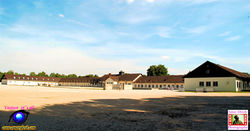top of page

Between 1933 and 1945, Nazi Germany and its allies established more than 44,000 camps for a range of purposes, including forced labour, detention of people deemed to be "enemies of the state," and mass murder. Millions of people suffered, died and killed. Among these sites was Dachau, the longest operating Concentration Camp. In the twelve years of its existence, over 200000 persons from all over Europe were imprisoned here and approx 41500 were killed in Dachau Concentration Camp
 The Jourhouse, or main entrance, of the Dachau Concentration Camp. The Jourhaus served as the main exit and entrance to the prisoners’ camp and as the main office of the camp |
|---|
![Entrance to Dachau, which translated means "Work Sets [You] Free"](https://static.wixstatic.com/media/9849f8_6d55e705178a4ef59fbfaf7939534169~mv2.jpg/v1/fill/w_250,h_167,al_c,q_90,enc_auto/9849f8_6d55e705178a4ef59fbfaf7939534169~mv2.jpg) Entrance to Dachau, which translated means "Work Sets [You] Free"This gate house was built by prisoners in 1936 and newly arriving prisoners were forced to pass through the gate with the inscription “Arbeit macht frei” (Work sets you free). It fulfilled the Nazi propaganda, portraying it as a “labor and re-education” camp. |
 Prisoner’s barracks |
 Prisoner’s barracks |
 Prisoner’s barracks |
 Dachau Memorial Sculpture by Nandor GlidSculpture depicting the twisted bodies of concentration camp victims remembering Dachau Concentration Camp |
 A sculpture in the form of a chain symbolizes the solidarity between the prisoners in the concentration camp. On this chain, you’ll find several triangles of various colors. These colored triangles were used to define the prisoners for their existence in the camp. Red for communists and political prisoners, blue for Poles and foreign workers, pink for homosexuals and the yellow double triangles or the Star of David for the Jews. |
 A memorial at Dachau Concentration Camp : Never Again“Never again” – two words, so simple and yet so profound. These were so important that they wrote them in 5 different languages at the memorial site. For me the words generate so many more questions – “How did it happen in the first place?” and “How can we be sure it doesn’t happen again?” |
 Monument commemorating the evacuation marches of prisoners from the Dachau Concentration Camp6,887 prisoners were evacuated from the Dachau Concentration Camp and forced to march south on April 26, 1945. Hubertus von Pilgrim created a bronze sculpture to commemorate the victims of this so-called death march. The sculpture was erected in Dachau, where the march began |
 The gas chamber used to murder individual prisoners & small groups using poisonous gasAccording to official records, 206,206 people have been deported to Dachau from 1933 onwards. The official death list states a number of 31,591 dead but the actual mortality figure in Dachau is probably higher |
 Large crematorium – erected between May 1942 and April 1943The crematoria were used to burn the dead bodies of the concentration camps and the ovens were mostly day and night in operation. In the autumn of 1944, the capacity of the furnaces for combustion of the many dead bodies from the camp was no longer enough. When the camp was liberated in late April 1945 by the Americans, were the countless bodies around the crematorium. |
 This crematorium was built in the summer of 1940The crematorium at the Dachau camp, where an estimated 41,500 died or were killed. |
 Picture shows a large number of bodies are dumped outside Barrack X Crematorium. The number of prisoners who died in the camp between 1933 and 1945 was at least 41500. It is unlikely that the actual number of victims who died in Dachau will ever be known. |
bottom of page